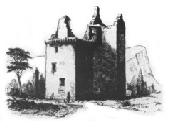|
Travel To Denmylne Castle, Newburgh, Scotland
The Den Mill stood near Newburgh next to a farm and was one of the six mills standing along the Priestsburn. The old threshing mill and gimel can still be seen. Both have old lintels above their doors with the date 1625 and the initials M.B. and J.D., which stand for Michael Balf our and Joanna Durham. These stones belong to a more ancient mill that has long since disappeared.
That milling has been practised here for centuries can be seen by the name of the castle, mylne -- being Gaelic for mill. The Castle itself was built in 1560. The lands of Denmylne early belonged to the Earls of Fife but fell to the Crown after the forfeiture of the last Earl. It is because of this that it was known as the King's Mill.
In 1451 James II bestowed the lands on James Balfour and from him descended the Balfours of Denmylne who held the castle and lands around for over two hundred years, and were in their time a noble and illustrious family. Sir Michael Balfour who was born in 1630 was Comptroller of the Household to Charles I and was knighted at Holy-rood. He died in 1652 at the age of 72 and was buried at Abdie. Sir Michael had five sons all of whom led very distinguished careers. The eldest Sir James was knighted in 1630 and raised to Baronetcy in 1633. He was the author of the "Annales' and collector of other heraldic manuscripts which are now in the Advocates Library in Edinburgh. The next son Alexander was the Minister of Abdie and the third Michael was an agriculturalist. Sir David of Forret was the fourth son and he was raised to the bench and became Lord Forret. The youngest, Sir Andrew, was the foremost physician of his time and together with Sir Robert Sibbald founded the Royal College of Physicians in Edinburgh, established the first infirmary in Scotland and last but by no means least founded the Botanic Gardens in Edinburgh.
Sir James the eldest son was made Lord Lyon King at Arms to Charles I and Charles II but is remembered chiefly for the great service that he rendered to later historians by his great interest in old charters and deeds which he collected from all manner of sources. This collection which was housed in chests was left in the castle long after it ceased to be inhabited and Dr. Laing tells an amusing story of receiving shoes from the shoemaker in Newburgh wrapped in old manuscripts from Sir James' collection. The remains of the records were ultimately rescued and safely lodged in Edinburgh.
Sir James died when he was fifty two, leaving as his heir Sir Robert -- then only six years old. Sir Robert died aged only twenty two years as the result of a duel. Sir Robert had been to a Fair in Perth with Sir James MacGill of Lindores and Sir Robert had argued and fought with a Highlander in the street. Sir James had interfered and stopped the fight and it is said that as they made their way home he had angered Sir Robert by remarking that if he had not interfered the Highlander would have overcome him. Sir Robert immediately drew his sword and challenged Sir James, who being older and an expert swordsman quickly struck Sir Robert down. As a result of this Sir James was sent into exile by Charles II and Denmylne went to Sir Robert's uncle the Minister of Abdie who died a year later. His son Michael succeeded and here the line ends.
The estate was then in difficulties and in the spring of 1709 Sir Michael rode out of the Castle to visit friends and strangely disappeared. The mystery has never been solved and although there were certain conjectures at the time the truth seems to be that both man and horse disappeared into one of the molasses that then abounded in Fife. The Estate was acquired by Major Gen. John Scott of Balcomie around 1773, and by 1840 was a complete ruin.
Home Page
|
|

